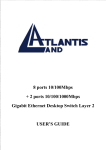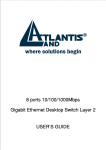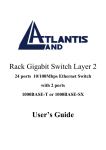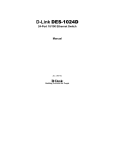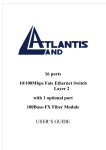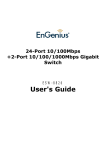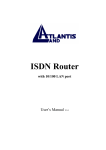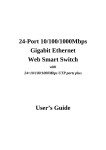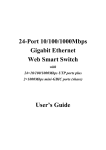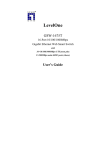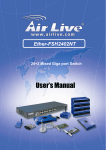Download Atlantis Land A02-G4(8)/M2 User`s guide
Transcript
4/8 ports 10/100/1000Mbps Gigabit Ethernet Desktop Switch Layer 2 USER’S GUIDE The Atlantis Land logo is a registered trademark of Atlants Land SpA. All other names mentioned mat be trademarks or registered trademarks of their respective owners. Subject to change without notice. No liability for technical errors and/or omissions. FCC Warning This equipment has been tested and found to comply with the limits for a Class B digital device, pursuant to Part 15 of the FCC Rules. These limits are designed to provide reasonable protection against harmful interference when the equipment is operated in a commercial environment. This equipment generates, uses, and can radiate radio frequency energy and, if not installed and used in accordance with this user’s guide, may cause harmful interference to radio communications. Operation of this equipment in a residential area is likely to cause harmful interference in which case the user will be required to correct the interference at his own expense. CE Mark Warning This is a Class B product. In a domestic environment, this product may cause radio interference in which case the user may be required to take adequate measures. A02-G4(8)/M2 (october 2002) TABLE OF C ONTENTS ABOUT THIS GUIDE ....................................................... 1 TERMS .............................................................................................. 1 OVERVIEW OF THIS USER’S GUIDE ................................................... 1 INTRODUCTION ................................................................. 2 GIGABIT ETHERNET TECHNOLOGY ................................................... 2 FAST ETHERNET TECHNOLOGY......................................................... 3 SWITCHING TECHNOLOGY ................................................................ 4 FEATURES ......................................................................................... 5 Ports ............................................................................................ 5 Performance features ............................................................... 5 UNPACKING AND SETUP .......................................... 6 UNPACKING ...................................................................................... 6 SETUP ............................................................................................... 6 DESKTOP OR SHELF INSTALLATION .................................................. 7 RACK INSTALLATION (OPTIONAL)..................................................... 7 CONNECTING NETWORK CABLE ....................................................... 8 POWER ON ........................................................................................ 9 IDENTIFYING EXTERNAL COMPONENTS ............................................................................................................. 9 FRONT PANEL ................................................................................. 10 REAR PANEL ................................................................................... 10 LED INDICATORS ........................................................................... 11 SUPPORT…………………………………………………………...1 3 TECHNICAL SPECIFICATIONS ......................... 13 i A BOUT T HIS G UIDE This user’s guide tells you how to install your 4(8)-port 10/100/1000Mbps Gigabit Ethernet Switch, how to connect it to your Gigabit Ethernet network. Terms For simplicity, this documentation uses the terms “Switch” (first letter upper case) to refer to the 4(8)-port 10/100/1000Mbps Gigabit Ethernet Switch, and “switch” (first letter lower case) to refer to all Ethernet switches, including the 4(8)-port 10/100/1000Mbps Gigabit Ethernet Switch. Overview of this User’s Guide ♦ Introduction. Describes the Switch and its features. ♦ Unpacking and Setup. Helps you get started with the basic installation of the Switch. ♦ Identifying External Components. Describes the front panel, rear panel, and LED indicators of the Switch. ♦ Connecting the Switch. Tells how you can connect the Switch to your Ethernet network. ♦ Technical Specifications. Lists the technical specifications of the 4(8)-port 10/100/1000Mbps Gigabit Ethernet Switch. 1 I NTRODUCTION This section describes the features of the 4(8)-port 10/100/1000Mbps Gigabit Ethernet Switch, as well as giving some background information about Gigabit Ethernet, Fast Ethernet and Switching technology. Gigabit Ethernet Technology Gigabit Ethernet is an extension of IEEE 802.3 Ethernet utilizing the same packet structure, format, and support for CSMA/CD protocol, full duplex, flow control, and management objects, but with a tenfold increase in theoretical throughput over 100-Mbps Fast Ethernet and a hundredfold increase over 10-Mbps Ethernet. Since it is compatible with all 10-Mbps and 100-Mbps Ethernet environments, Gigabit Ethernet provides a straightforward upgrade without wasting a company’s existing investment in hardware, software, and trained personnel. The increased speed and extra bandwidth offered by Gigabit Ethernet is essential to coping with the network bottlenecks that frequently develop as computers and their busses get faster and more users use applications that generate more traffic. Upgrading key components, such as your backbone and servers to Gigabit Ethernet can greatly improve network response times as well as significantly speed up the traffic between your subnets. Gigabit Ethernet enables fast optical fiber connections to support video conferencing, complex imaging, and similar data-intensive applications. Likewise, since data transfers occur 10 times faster than Fast Ethernet, servers outfitted with Gigabit Ethernet NIC’s are able 2 to perform 10 times the number of operations in the same amount of time. In addition, the phenomenal bandwidth delivered by Gigabit Ethernet is the most cost-effective method to take advantage of today and tomorrow’s rapidly improving switching and routing internetworking technologies. And with expected advances in the coming years in silicon technology and digital signal processing that will enable Gigabit Ethernet to eventually operate over unshielded twisted-pair (UTP) cabling, outfitting your network with a powerful 1000-Mbpscapable backbone/server connection creates a flexible foundation for the next generation of network technology products. Fast Ethernet Technology The growing importance of LANs and the increasing complexity of desktop computing applications are fueling the need for high performance networks. A number of high-speed LAN technologies have been proposed to provide greater bandwidth and improve client/server response times. Among them, 100BASE-T (Fast Ethernet) provides a non-disruptive, smooth evolution from the current 10BASE-T technology. The non-disruptive and smooth evolution nature, and the dominating potential market base, virtually guarantee cost effective and high performance Fast Ethernet solutions in the years to come. 100Mbps Fast Ethernet is a new standard specified by the IEEE 802.3 LAN committee. It is an extension of the 10Mbps Ethernet standard with the ability to transmit and receive data at 100Mbps, while maintaining the CSMA/CD Ethernet protocol. Since the 100Mbps Fast Ethernet is compatible with all other 10Mbps Ethernet 3 environments, it provides a straightforward upgrade and takes advantage of the existing investment in hardware, software, and personnel training. Switching Technology Another key development pushing the limits of Ethernet technology is in the field of switching technology. A switch bridges Ethernet packets at the MAC address level of the Ethernet protocol transmitting among connected Ethernet or fast Ethernet LAN segments. Switching is a cost-effective way of increasing the total network capacity available to users on a local area network. A switch increases capacity and decreases network loading by making it possible for a local area network to be divided into different segments which don’t compete with each other for network transmission capacity, giving a decreased load on each. The switch acts as a high-speed selective bridge between the individual segments. Traffic that needs to go from one segment to another is automatically forwarded by the switch, without interfering with any other segments. This allows the total network capacity to be multiplied, while still maintaining the same network cabling and adapter cards. Switching LAN technology is a marked improvement over the previous generation of network bridges, which were characterized by higher latencies. Routers have also been used to segment local area networks, but the cost of a router and the setup and maintenance required make routers relatively impractical. Today’s switches are an ideal solution to most kinds of local area network congestion problems. 4 Features The 4(8)-port 10/100/1000Mbps Gigabit Ethernet Switch was designed for easy installation and high performance in an environment where traffic on the network and the number of users increase continuously. Switch features include: Ports ♦ 4(8) 10/100/1000Mbps Gigabit Ethernet port Performance features ♦ ♦ ♦ ♦ ♦ ♦ ♦ ♦ ♦ ♦ ♦ Auto MDI/MDI-X for each port Support Full/Half duplex transfer mode for 10 and 100Mbps Support Full duplex transfer mode for 1000Mbps Wire speed reception and transmission Store-and-Forward switching method Supports 8K absolute MAC addresses Supports 256K Bytes RAM for data buffering Extensive front-panel diagnostic LEDs IEEE 802.3x flow control for full-duplex Back pressure flow control for half-duplex Optional Rack-mount Kit for 19” standard rack 5 U NPACKING AND S ETUP This chapter provides unpacking and setup information for the Switch. Unpacking Open the shipping carton of the Switch and carefully unpack its contents. The carton should contain the following items: ♦ One 4(8)-port 10/100/1000Mbps Gigabit Ethernet Switch ♦ Four rubber feet with adhesive backing ♦ One AC power cord ♦ This User’s Guide (CD-Rom) If any item is found missing or damaged, please contact your local reseller for replacement. Setup The setup of the Switch can be performed using the following steps: ♦ The surface must support at least 5 kg. ♦ The power outlet should be within 1.82 meters (6 feet) of the device. ♦ Visually inspect the power cord and see that it is secured fully to the AC power connector. 6 ♦ Make sure that there is proper heat dissipation from and adequate ventilation around the Switch. Do not place heavy objects on the Switch. Desktop or Shelf Installation When installing the Switch on a desktop or shelf, the rubber feet included with the device must be first attached. Attach these cushioning feet on the bottom at each corner of the device. Allow enough ventilation space between the device and the objects around it. Gigabit Ethernet Switch installed on a Desktop or Shelf Rack Installation (optional) The 4(8)-port 10/100/1000Mbps Gigabit Ethernet Switch can be mounted in an EIA standard size, 19-inch rack, which can be placed in a wiring closet with other equipment. To install, attach the 7 mounting brackets on the switch’s front panel (one on each side) and secure them with the screws provided. Attaching the mounting brackets to the Switch Then, use the screws provided with the equipment rack to mount the Switch in the rack. Installing the Switch in an equipment rack Connecting Network Cable The 4(8)-Port 10/100/1000Mbps Gigabit Ethernet Switch supports four or eight 10/100/1000Mbps Gigabit Ethernet ports. These ports runs both half duplex and full duplex while they’re running in 10Mbps or 100Mbps and runs full duplex while they’re running in 1000Mbps. 8 These ports are Auto-MDI type port, these ports can auto transform to MDI-II or MDI-X type, so you can just make an easy connection that without worrying if you are using a standard or crossover cable. Power on The 4(8)-port Gigabit Ethernet Switch can be used with AC power sources 100~240V AC, 50~60 Hz. The power supply of the Switch will adjust to the local power source automatically and may be turned on without having any or all LAN segment cables connected. I DENTIFYING E XTERNAL C OMPONENTS This chapter describes the front panel, rear panel and LED indicators of the Switch 9 Front Panel The front panel of the Switch consists of 4(8) Gigabit Ethernet port, and LED indicators. LED Indicators 1000BASE-T Gigabit Ethernet Ports Front panel view of the 4-port 10/100/1000Mbps Gigabit Ethernet Switch ♦ Four(Eight) 10/100/1000Mbps Gigabit Ethernet ports ♦ Comprehensive LED indicators that display the conditions of the Switch and status of the network. A description of these LED indicators follows (see LED Indicators). Rear Panel The rear panel of the Switch consists of an AC power connector. The following shows the rear panel of the Switch. Rear panel view of the 4-port 10/100/1000Mbps Gigabit Ethernet Switch 10 ♦ AC Power Connector This is a three-pronged connector that supports the power cord. Plug in the female connector of the provided power cord into this connector, and the male into a power outlet. Supported input voltages range from 100 ~ 240 V AC at 50 ~ 60 Hz. LED Indicators The LED indicators of the Switch include Power, Link/Act, 1000Mbps and 100Mbps. The following shows the LED indicators for the Switch along with an explanation of each indicator. The 4-port 10/100/1000Mbps Gigabit Ethernet Switch LED indicators ♦ POWER: This indicator lights green when the Switch is receiving power, otherwise, it is off. ♦ LINK/ACT: These LED indicators are lighted up when there is a secure connection (or link) to the desired port. The LED indicators blinking whenever there is reception or transmission (i.e. Activity—Act) of data occurring at a port. 11 ♦ 1000Mbps : These LED indicators are lighted up when there is a secure connection (or link) to 1000Mbps Gigabit Ethernet device at the desired port. ♦ 100Mbps: These LED indicators are lighted up when there is a secure connection (or link) to 100Mbps Fast Ethernet device at the desired port. When the connection (or link) is 10Mbps, both 1000Mbps and 100Mbps LED indicators are off. Product Support If you continue to have problems you should contact the dealer where you bought this product. If you have any other questions you can contact the Atlantis Land company directly at the following address: AtlantisLand spa Via Gandhi 5 Ing2,Scala A 20017 Mazzo di Rho(MI) Tel: 02/93906085, 02/93907634(help desk) Fax: 02/93906161 Email: [email protected] or [email protected] WWW: http://www.atlantisland.it or www.atlantis-land.com 12 T ECHNICAL S PECIFICATIONS General IEEE 802.3 10BASE-T Ethernet IEEE 802.3u 100BASE-TX Fast Ethernet Standards: IEEE 802.3ab 1000BASE-T Gigabit Ethernet ANSI/IEEE 802.3 Auto-negotiation IEEE 802.3x Full duplex Flow Control Protocol: CSMA/CD Data Transfer Rate: Ethernet: 10Mbps (half-duplex), 20Mbps (full-duplex) Topology Star Network Cables: Number of Ports: Fast Ethernet: 100Mbps (half-duplex), 200Mbps (full-duplex) Gigabit Ethernet: 2000 Mbps (full-duplex) Ethernet: 2-pair UTP Cat. 3/4/5 Fast Ethernet: 2-pair UTP Cat.5 Gigabit Ethernet: 4-pair UTP Cat. 5 4(8) x 10/100/1000Mbps Gigabit Ethernet Auto-MDI port 13 Physical and Environmental AC inputs: 100 – 240 VAC, 50/60 Hz Power Consumption: 12 watts max(4 ports), 20 watts max (8 ports) Operating Temperature: 0 ~ 40 degrees Celsius Storage Temperature: -10 ~ 55 degree Celsius Humidity: 5% ~ 95% RH, non-condensing Dimensions: 280 mm x 180 mm x 44 mm EMI: FCC Class A, CE Mark Class A, VCCI-A Safety: UL (UL 1950), TUV/GS (EN60950) Performance Transmission Method: Store-and-forward RAM Buffer: 256K bytes per device Filtering Address Table: 8K MAC address per device Packet Filtering / Forwarding Rate: Full wire speed MAC Address Learning: Self-learning, Auto-aging 14

















